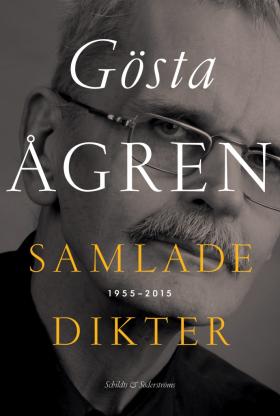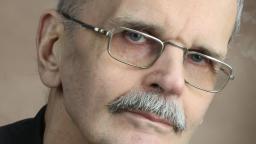
Samlade dikter 1955-2015
(Collected Poems, 1955-2015)
by Gösta Ågren
reviewed by David McDuff
The work of Gösta Ågren holds a special place in Finland-Swedish – and Swedish and Finnish – literature. While he was a true creative individualist in the mould of some of the most formidable figures of the Nordic literary past, with them he shared a passionate engagement with social, pedagogical, aesthetic, political, ethical, philosophical and psychological issues. Although it’s still too early to make a detailed assessment of Ågren’s output – for the time being it remains a territory still largely waiting to be discovered by mainstream criticism and international appreciation – the scope of his attainment can be viewed in this substantial volume, which covers seven decades of poetic activity.
Ågren grew up in Nykarleby (Uusikaarlepyy), the Ostrobothnian town that was also the childhood home of Zacharias Topelius, the Finnish historian, poet and educator who played a major part in laying the foundations of the modern Finnish republic. From an early age, Ågren concentrated on reading and writing at home, with authorship being considered ‘the most important profession in society’, according to his autobiographical account in Detta liv (This Life, 2001). With the authorship spread between siblings Gösta, Erik, Leo and Inga, the modest family home produced work in almost every genre, from plays and novels to poetry and aphorisms. At the age of 19 Gösta Ågren published his first collection of poetry, Kraft och tanke (Power and thought, 1955), earning his living as a metal worker, a reporter on a left-wing newspaper and an assistant librarian.
Looking through the collections of 60 years, one is struck by the homogeneous nature and appearance of the poems. In their brevity, immediacy, concision and aphoristic reserve they resemble nothing so much as columns of newsprint, telegraphed reports from a local, personal world that is also the world in general as it percolates into our consciousness day and night. Others have seen echoes of figurative art: the critic Pekka Tarkka writes that the poems are ‘monuments to eternity and the present day, shapes that impress themselves on the winds of time like Henry Moore’s sculptures.’
The twin focal points in the volume are the collections Jär (Standing here, 1988) and En dal i våldet (A Valley in the Violence, 1990). In the first, the poet returns to his Ostrobothnian roots and his family. Deceased family members are brought to life with a startling vividness that reflects back on him, illuminating his own existence:
Moder, jag längtar hem
till detta hus, där jag bor,
och denna korta höstdag,
när ja lever.Mother, I am homesick
for this house, where I dwell,
and this short autumn day,
when I live.Great Grandmother, Mormorsmor
In the second book, Ågren presented a selection of all the poems he wanted to preserve from the years 1955 to 1985. Far from being an act of self-censorship, this was a way of clearing a path into the future, of making it possible to advance with independence from the labels placed on morally and politically committed work by uncommitted and possibly noncommittal critics. The poems chosen are remarkable for their individuality and starkness of response, and for their quiet lyricism:
Genom de långsamma skuggorna
nalkas korna, varma
kvällsmödrar, som snarare dröjer,
än går.Through the slow shadows
the cows approach, warm
evening mothers, that rather stay
than go.Barndomsommar, Childhood summer
Here one can detect the authentic voice of Finland-Swedish modernism, the twentieth-century literary tradition in Finland that bound itself to Anglo-American and German movements like Imagism and Expressionism. Here also perhaps there is the recollection of a statement by Rabbe Enckell, one of Ågren’s favourite poets, and a Finland-Swedish ally and confrère of T.S. Eliot. Enckell’s poetry is now unjustly neglected, perhaps to some extent because of the uncomfortable truth that it imparts. He was speaking to the radicals of the 1960s, but his words are still relevant today:
Must writers act in prisons, hospitals and places of work in the capacity of teachers, consolers and consultants? But am I able to teach, give consultation or preach?... To communicate one’s thoughts and feelings in writing in the form one is seeking and which suits one – that is what being a writer means. As for the rest, each may take up a position according to his or her ability. But on demand? I would rather be considered a reject fit only for the dustbin than act in a role I have not chosen and am not equal to.
It is good to have a decently comprehensive collection of Ågren’s work in a single volume, as so many of the individual collections branch out from one another and are interconnected. One might complain a bit about the format chosen by the publisher – the font is rather small, and poems are split now and then by page-breaks, when they need to be presented on a single page. While one appreciates that this might result in an unwieldy volume, the point is both aesthetic and cognitive, and could have a negative effect on a reader’s experience.

Samlade dikter 1955-2015
Schildts & Söderströms (Finland), 2016
552 pages.
Foreign rights: Mari Koli, Schildts & Söderströms.
Gösta Ågren (1936-2020) made his debut in 1955. In a career that spanned over 60 years, he published numerous volumes of poetry and won numerous awards, including the Finlandia Prize.
